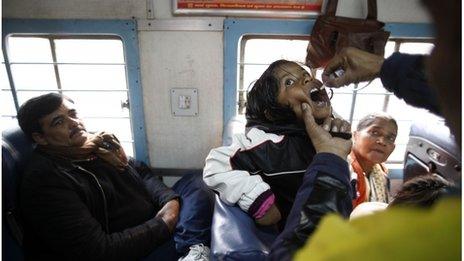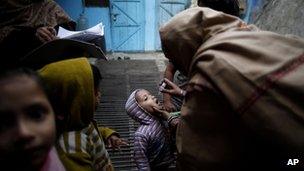India's battle to finish off polio
- Published

India has managed an entire year with no new cases of polio
"Just two drops" may become the quintessential public health war cry of the 21st Century in the massive global movement to finish off polio.
Certainly it will for India, exhilarated by its most recent success against the highly infectious viral disease capable of causing total and irreversible paralysis within hours.
On 13 January 2012, half a century after Jonas Salk made the first great discovery of a vaccine against polio - followed soon after by Albert Sabin's oral version - India managed an entire year with no new cases.
"A giant leap in a short span of two years," is what Minister for Health and Family Welfare Ghulam Nabi Azad called the achievement - which it is.
'Excited and hopeful'
Till not so long ago, the idea of a polio-free India was far-fetched.
In 2009, there were 741 cases in the country, nearly half the total number across the world. This dropped to a record low of 42 in 2010. The lone case in 2011 was a two-year-old girl in Panchla block, Howrah, in West Bengal.
But zero cases between January 2011 and now? Nobody expected that. Polio-endemic Uttar Pradesh and Bihar were case-free for a year.

Three years must pass without any case before India can be certified as having eradicated polio
India leaves behind Pakistan, Afghanistan and Nigeria, the other three members of the infamous PAIN group of nations with polio.
Great news, undoubtedly, and the opportunity for millions of Indian children to be free from a devastating infection.
But the challenges it brings are also written on the wall, as Mr Azad says: "We are excited and hopeful, at the same time, vigilant and alert."
A full three years must pass without any case before India can be certified as having eradicated polio.
Risks of virus importation always remain, and border movement requires vigilance - especially with polio-endemic Pakistan.
Further detections within India remain a possibility and there are pending laboratory investigations.
Only when these investigations come back negative will India be officially declared to have stopped transmission of indigenous wild polio virus.
There is also the threat of vaccine-induced polio infection - when vaccinated children excrete the virus after receiving Oral Poliovirus Vaccine (OPV) and it regains its neuro-virulence in the environment, then returning to infect children.
The other challenge is in the tantalising thought that the same success may well be repeatable - to help control major killers like TB, pneumonia, diarrhoea and malaria.
As if on cue from the polio success, the ministry of health and family welfare declared, on 16 January, that 2012 would be India's year of intensification of routine immunisation - the customary six vaccinations most people give to their children.
The announcement promises deploying large numbers of health workers to cover more and more children under the Universal Immunisation Programme (UIP), one of the world's largest immunisation programmes, covering some 26 million children born each year.
As of date, about 40% of India's children are left out of the UIP - upping these numbers would make a huge difference to current infant mortality rates in the country (57 per 1,000 live births according to the National Family Health Survey of 2005-2006 but as low as 15 in the state of Kerala).
Can the war-footing kind of effort to remove polio be replicated?
World Health Organisation Director General Margaret Chan has called for the global adaptation of the Indian lessons to finish polio everywhere.
India's Pulse Polio Programme was launched in 1995. The government spent more than $2.5bn orchestrating armies of vaccinators during each immunisation round (there are two such days per year).
Working under 150,000 supervisors they administered Oral Polio Vaccine (OPV) to children in numbers equal to the entire population of Pakistan (almost 172 million under-five children).
Of the three strains of wild polio virus, P1, P2 and P3, P2 was eliminated in 1999.
Effective monovalent OPVs were introduced in 2005 and, in 2010, the bivalent polio vaccine (bOPV) was introduced, helping curtail both P1 and P3. Surveillance is rigorous - 35,325 reporting sites across the country are active and pick up cases of Acute Flaccid Paralysis.
Today, unacceptably high numbers of children below the age of five are succumbing to pneumonia and diarrhoea - both top causes of death in this age group.
Both are conditions that can easily be prevented or treated, and their management is in dire need of focused attention from the health workforce.
Just detecting pneumonia early enough can make the difference between life and death, and the Oral Rehydration Solution (ORS), although effective against diarrhoea, is grossly underused - hardly a quarter of children with diarrhoea receive ORS.
At least 80,000 children die of measles each year, but measles vaccination through the UIP is not more than 70%.
Crippling shortages
Hamid Jafari, project manager of the WHO-National Polio Surveillance Project (NPSP), has said this is the closest the world has come to global eradication of polio.
But it's difficult to envision deploying tens of millions of health workers for a single disease each time, especially since the Indian health system faces crippling health human resource shortages.
Integrating well-managed programmes and strengthening health services may be the only way out.
The two drops to freedom may be great reminders to get the job done.
Dr Subhadra Menon is Head, Communication, The Public Health Foundation of India and author of No Place to Go: Stories of Hope and Despair from India's Ailing Health Sector, published by Penguin Books. The views expressed are personal.
- Published12 January 2012
- Published1 October 2011
- Published21 July 2011